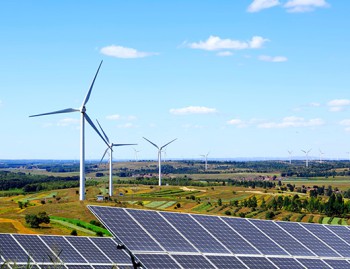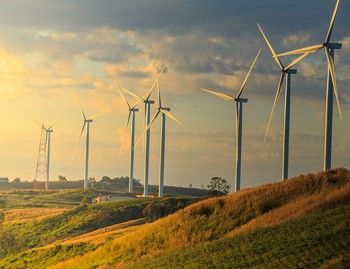INTRODUCTION
The Indian renewable energy sector is the fourth most attractive renewable energy market in the world. India was ranked fourth in wind power, fifth in solar power and fourth in renewable power installed capacity, as of 2020.
Installed renewable power generation capacity has gained pace over the past few years, posting a CAGR of 17.33% between FY16-20. With the increased support of Government and improved economics, the sector has become attractive from an investors perspective. As India looks to meet its energy demand on its own, which is expected to reach 15,820 TWh by 2040, renewable energy is set to play an important role. The government plans to establish renewable energy capacity of 523 GW (including 73 GW from Hydro) by 2030.

MARKET SIZE
As of January 2022, India’s installed renewable energy capacity stood at 152.36 GW, representing 38.56% of the overall installed power capacity. 975.60 MW of renewable energy capacity was added in January 2022. Power generation from renewable energy sources stood at 13.15 billion units (BU) in January 2022, up from 11.51 BU in January 2021.
The country is targeting about 450 Gigawatt (GW) of installed renewable energy capacity by 2030 – about 280 GW (over 60%) is expected from solar. The renewable energy capacity addition stood at 8.2 GW for the first eight months of FY22 against 3.4 GW for the first eight months of FY21. ICRA expects renewable energy capacity addition of 12.5 GW in FY22 and 16 GW in FY23.
Solar power installed capacity has increased by more than 18 times from 2.63 GW in March 2014 to 49.3 GW in at the end of 2021. In FY22, till December 2021, India has added 7.4GW of solar power capacity, up 335% from 1.73 GW in the previous year. Off-grid solar power is growing at a fast pace in India, with sales of 329,000 off-grid solar products in the first half of 2021.
With a potential capacity of 363 GW and with policies focused on the renewable energy sector, Northern India is expected to become the hub for renewable energy in India.
INVESTMENTS/DEVELOPMENTS
According to the data released by Department for Promotion of Industry and Internal Trade (DPIIT), FDI inflow in the Indian non-conventional energy sector stood at US$ 11.21 billion between April 2000-December 2021. More than Rs. 5.2 lakh crore (US$ 70 billion) has been invested in India’s renewable energy sector since 2014. According to the analytics firm British Business Energy, India ranked 3rd globally in terms of its renewable energy investments and plans in 2020.
Some major investments and developments in the Indian renewable energy sector are as follows:
- India ranked third on the EY Renewable Energy Country Attractive Index 2021.
- In February 2022, Creduce Technologies-HCPL JV announced winning the bid for India’s single largest hydro power carbon credits project with Satluj Jal Vidyut Nigam, which will create more than 80 million carbon credits.
- In February 2022, Husk Power Systems, a renewable energy company working towards rural electrification, secured a US$ 4.2 million loan from the Indian Renewable Energy Development Agency (IREDA).
- In December 2021, India's largest energy provider, Tata Power, was awarded a contract by the Maharashtra State Electricity Distribution Company Limited (MSEDCL) to set up a 300 MW wind-solar hybrid power plant.
- In October 2021, Reliance New Energy Solar Ltd. (RNESL) announced two acquisitions to build more capabilities. Both acquisitions – REC Solar Holdings AS (REC Group), a Norway-based firm, and Sterling & Wilson Solar, based in India – exceeded US$ 1 billion and are expected to contribute to Reliance’s target of achieving the capacity of 100 GW of solar energy at Jamnagar by 2030.
- In October 2021, Adani Green Energy Ltd. (AGEL) acquired SB Energy India for US$ 3.5 billion to strengthen its position in the renewable energy sector in India.
- In August 2021, Copenhagen Infrastructure Partners (CIP) signed an investment agreement with Amp Energy India Private Limited to facilitate joint equity investments of US$ 200 million across Indian renewable energy projects.
- In July 2021, National Thermal Power Corporation Renewable Energy Ltd. (NTPC REL), NTPC's fully owned subsidiary, sent out a tender to domestic manufacturers to build India's first green hydrogen fueling station in Leh, Ladakh.
- In June 2021, Reliance Industries announced to invest Rs. 750,00 crore (US$ 10.07 billion) in the green energy segment.
- In June 2021, Suzlon secured a contract for 252 MW wind power project from CLP India. The project is expected to be commissioned in 2022.
- In June 2021, Tata Power Solar secured a contract worth Rs. 686 crore (US$ 93.58 million) from the NTPC to build 210 MW projects in Gujarat.
- In May 2021, Virescent Infrastructure, a renewable energy platform, acquired 76% of India’s solar asset portfolio of Singapore-based Sindicatum Renewable Energy Company Pte Ltd.
- In April 2021, GE Power India's approved the acquisition of 50% stake in NTPC GE Power Services Pvt. Ltd. for Rs 7.2 crore (US$ 0.96 million)..
- The NTPC is expected to commission India’s largest floating solar power plant in Ramagundam, Telangana by May-June 2022. The expected total installed capacity is 447MW.
- The Solar Energy Corporation of India (SECI) implemented large-scale central auctions for solar parks and has awarded contracts for 47 parks with over 25 GW of combined capacity.
GOVERNMENT INITIATIVES
Some initiatives by Government of India to boost India’s renewable energy sector are as follows:
- In the Union Budget 2022-23, the allocation for the Solar Energy Corporation of India (SECI), which is currently responsible for the development of the entire renewable energy sector, stood at Rs. 1,000 crores (US$ 132 million).
- In the Budget, the government allocated Rs. 19,500 crore (US$ 2.57 billion) for a PLI scheme to boost manufacturing of high-efficiency solar modules.
- In February 2022, Nepal and India agreed to form a Joint Hydro Development Committee to explore the possibility of viable hydropower projects.
- In November 2021, at the COP-26 Summit in Glasgow, Prime Minister Mr. Narendra Modi made a promise to increase India’s renewable energy generation capacity to 500 GW, and meet 50% of India’s energy needs through renewable means by the year 2030.
- In October 2021, the Ministry of Power announced a new set of rules aimed at reducing financial stress for stakeholders and safeguarding timely cost recovery in electricity generation.
- In August 2021, the Indian government proposed new rules for the purchase and consumption of green energy. The latest rules are a part of government measures to encourage large-scale energy consumers, including industries, to leverage renewable energy sources for regular operations.
- In July 2021, to encourage rooftop solar (RTS) throughout the country, notably in rural regions, the Ministry of New and Renewable Energy plans to undertake Rooftop Solar Programme Phase II, which aims to install RTS capacity of 4,000 MW in the residential sector by 2022 with a provision of subsidy.
- In July 2021, the Ministry of New and Renewable Energy (MNRE) gave the go ahead to NTPC Renewable Energy Ltd., a 100% subsidiary of NTPC, to build a 4,750 MW renewable energy park at the Rann of Kutch in Khavada, Gujarat. This will be India's largest solar park to be developed by the country's leading power producer.
- In June 2021, India launched the Mission Innovation CleanTech Exchange, a global initiative that will create a whole network of incubators across member countries to accelerate clean energy innovation
- In June 2021, Indian Renewable Energy Development Agency Ltd. (IREDA) invited bids from solar module manufacturers for setting up solar manufacturing units under the central government’s Rs. 4,500 crore (US$ 616.76 million) Production Linked Incentive (PLI) scheme.
- In April 2021, the Central Electricity Authority (CEA) and CEEW’s Centre for Energy Finance (CEEW-CEF) jointly launched the India Renewables Dashboard that provides detailed operational information on renewable energy (RE) projects in India.
- In April 2021, the Ministry of Power (MoP) released the draft National Electricity Policy (NEP) 2021 and has invited suggestions from all stakeholders such as Central Public Sector Undertakings, Solar Energy Corporation of India, power transmission companies, financial institutions like Reserve Bank of India, Indian Renewable Energy Development Agency, HDFC Bank, ICICI Bank, industrial, solar, and wind associations, and state governments.
- The Government of India has announced plans to implement a US$ 238 million National Mission on advanced ultra-supercritical technologies for cleaner coal utilisation.
- Indian Railways is taking increased efforts through sustained energy efficient measures and maximum use of clean fuel to cut down emission level by 33% by 2030.
- The government has spent US$ 4.63 billion on hydroelectric projects to provide electricity to villages in Jammu and Kashmir from 2018-21.
ROAD AHEAD
The Government is committed to increased use of clean energy sources and is already undertaking various large-scale sustainable power projects and promoting green energy heavily. In addition, renewable energy has the potential to create many employment opportunities at all levels, especially in rural areas. India’s renewable energy sector is expected to attract investment worth US$ 80 billion in the next four years. About 5,000 compressed biogas plants will be set up across India by 2023.
In 2022, India's renewable energy sector is expected to boom with a likely investment of US$ 15 billion this year, as the government focuses on electric vehicles, green hydrogen, and manufacturing of solar equipment.
It is expected that by 2040, around 49% of the total electricity will be generated by renewable energy as more efficient batteries will be used to store electricity, which will further cut the solar energy cost by 66% as compared to the current cost. Use of renewables in place of coal will save India Rs. 54,000 crore (US$ 8.43 billion) annually.

As per the Central Electricity Authority (CEA) estimates, by 2029-30, the share of renewable energy generation would increase from 18% to 44%, while that of thermal is expected to reduce from 78% to 52%.
The Government of India wants to develop a ‘green city’ in every state of the country, powered by renewable energy. The ‘green city’ will mainstream environment-friendly power through solar rooftop systems on all its houses, solar parks on the city’s outskirts, waste to energy plants and electric mobility-enabled public transport systems.
Note: 1- According to Renewable Energy Country Attractiveness index 2018 by EY; 2- As per data from the Economic Survey; *According to the Bloomberg New Energy Outlook 2018; 3 - Greenpeace India, Union Budget 2021-22, SPV - Solar Photovoltaic System, MWeq - Megawatt Equivalent
References: Central Electricity Authority, Ministry of New and Renewable Energy, Media Reports, Press Releases
Note: Conversion rate used in October 2021, Rs. 1 = US$ 0.013
Disclaimer: : This information has been collected through secondary research and IBEF is not responsible for any errors in the same.
Renewable Energy Hubs
- Rajasthan
- Gujarat
- Andhra Pradesh
- Karnataka
- Telangana
- Tamil Nadu

Industry Contacts
- Solar Energy Corporation of India (SECI)
- The Indian Renewable Energy Development Agency (IREDA)
- National Institute of Wind Energy (NIWE)
- National Institute of Solar Energy (NISE)